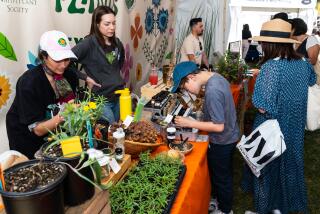Market Watch: Olive oil, from the hills of Topanga
In the last two decades, there’s been a tremendous surge in production of artisanal olive oil in California as consumers have developed an appreciation for the freshness, high quality and distinctive flavors that good locally produced oil can provide. This boom has carried over into farmers markets, where there has been a rush of new vendors, although many of them are not certified producers who are required to grow what they sell. Of the olive growers who are, one of the most intriguingly local is Joyce Lukon of Robinson Road Olive Ranch, who harvested her small crop last Sunday from a hillside next to her home in Topanga.
Her story well illustrates the pleasures and limitations of small-scale local production. A tax and investment advisor who works in Manhattan Beach, Lukon bought the 3.5-acre plot in 2004 as an investment, although the house was a wreck and the land was overgrown, she said; one plan was to fix it up and sell it for a profit. She planted an acre of Bordeaux-style wine grapes in 2005 to make the property more attractive, and as she looked for another crop suited to the area’s Mediterranean climate, she read a book, “Olives: The Life and Lore of a Noble Fruit,” by Mort Rosenblum, and was captivated by the romance of olive cultivation.
In May 2007, Lukon planted 950 olive trees on 1 1/4 acres with a gorgeous view of Topanga Canyon, on a hillside that the trees now protect against erosion as a bonus. Traditional olive orchards in Europe and California consisted of large, widely spaced trees, but Lukon adopted a super-high-density plan developed in the early 1990s in Spain, with much smaller, bush-like trees, planted in hedgerows, almost like a vineyard.
In commercial settings, super-high-density orchards allow producers to reduce costs by using continuous harvesting machines, but on this modest plot the main appeal of smaller trees is that they come into full production much earlier than standard trees and are easier to access without ladders on the steep hillside. Lukon chose two low-vigor Spanish varieties suited to the super-high-density system, Arbequina and Arbosana, the latter planted every fifth tree as a pollinator.
She took classes in the sensory analysis of olive oil taught at UC Davis by Paul Vossen, a Sonoma County farm advisor who has been a prime inspiration of the California artisanal olive oil boom, and he later visited several times to advise her. In 2009 and 2010, Lukon sent the fruit immediately after harvest to presses in Ojai and Templeton. Prompt pressing is crucial for ensuring quality, and her oil is certified extra virgin by the California Olive Oil Council, which awarded her 2009 oil a silver medal.
“It’s one of the best Arbequinas that I’ve tasted,” says Vossen. “It’s very fruity, nutty and buttery, with a slight flavor of artichoke. It’s a mild flavor, perfect for fish, potatoes, baking and other uses where you don’t want an overpowering taste.”
Lukon now sells her oil, $25 for a tall 375-milliliter bottle, at two farmers markets: Redondo Beach Riviera Village on Fridays and Manhattan Beach on Tuesdays; it is also available by mail order and at Canyon Gourmet in Topanga.
She is not certified organic but says she uses exclusively organic growing practices, including an organically approved Spinosad insecticide to fight the olive fruit fly, which has become a scourge to California growers since its first detection here in 1998.
This year, however, she was hit with a double whammy. Olive trees can be alternate bearing, and bad weather during bloom this year reduced the crop of coastal producers such as Lukon by 80%, says Vossen. In addition, this was a particularly nasty year for olive fruit flies, which spoiled much of the crop that remained.
As a result, Lukon’s usable harvest was too scanty to make it worthwhile to press oil, so she decided to make the best of things by brining the black olives, using a recipe given to her by a Jordanian friend. The process takes several weeks, so she should have brined black olives to sell at her markets in early to mid-January. Her oil from the December 2010 pressing remains in good condition, but come February, she’ll take a break from selling to focus on her tax preparation work.
Despite the short crop, a festive mood prevailed on Sunday as half a dozen of Lukon’s friends came to help two professional workers with the harvest, scrambling up the steep, rocky slopes to pick the small fruits and put them into plastic buckets. Antonella Manca-Mangoff, president of the Olive Oil Council of Canada, flew down from Toronto just for the occasion, to enjoy the harvest and the beauty of the site.
For her part, Lukon is now so in love with the property that she has decided not to sell it. “When I drive through the gate and see the olives and the hills beyond, it’s like entering heaven,” she says.
More to Read
Eat your way across L.A.
Get our weekly Tasting Notes newsletter for reviews, news and more.
You may occasionally receive promotional content from the Los Angeles Times.






